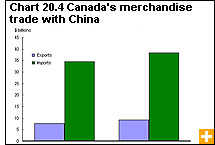Common menu bar links
Exports to China are growing
Canada’s merchandise trade with China has grown quickly this decade. China emerged as Canada’s second largest trading partner in 2003; by 2007, our total trade with China—exports and imports—reached $47.6 billion, and accounted for 6% of Canada’s world trade. That still pales next to Canada’s $625.9 billion worth of trade with the United States, which made up 70% of Canada’s world trade of $878.1 billion in 2007. However, it marks strong expansion.
Exports to China comprised 17% of Canada’s export growth in 2007. This growth lifted China to overtake Japan as Canada’s third largest export market, behind the United States and the United Kingdom.
China has become a manufacturing powerhouse: the industrialization process and its citizens’ newfound affluence have put pressure on world prices for natural resources, including Canada’s.
Canadian exports to China jumped 21% in 2007 from 2006, and surpassed $9 billion, nearly twice their value in 2003. Industrial goods dominated the advance: metals to manufacture stainless steel, infrastructure, machinery and electronics; fertilizers to raise crops; synthetic rubber and plastics to make toys and consumer goods; and organic chemicals to produce polyester for clothing. Forest products, such as pulp for paper and cardboard, were also a key export in 2007, as were agricultural products, especially canola seed and oil.
Imports from China—up 11% to $38 billion in 2007—have been boosted by the higher loonie: it gained 10% against the Chinese yuan in 2007 alone. Since 2002, China has been the second largest supplier of foreign goods to Canadians. Mostly, Canadians are importing high-tech products and equipment from China. Also popular are games, toys, apparel, footwear, furniture and fixtures.


